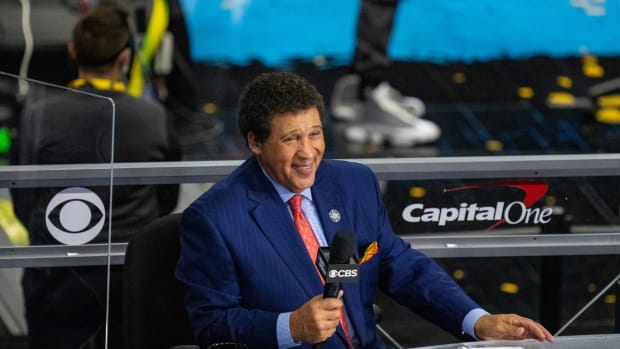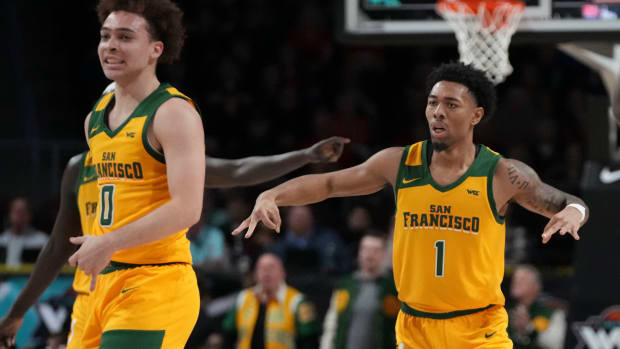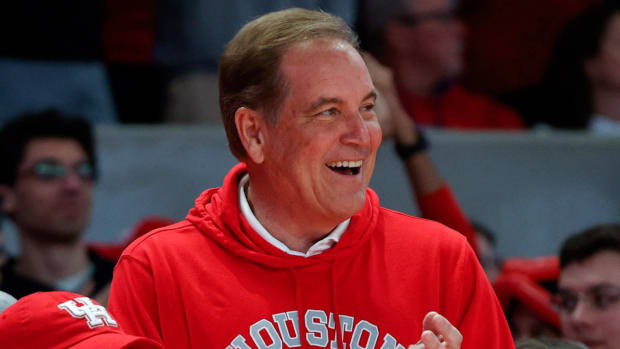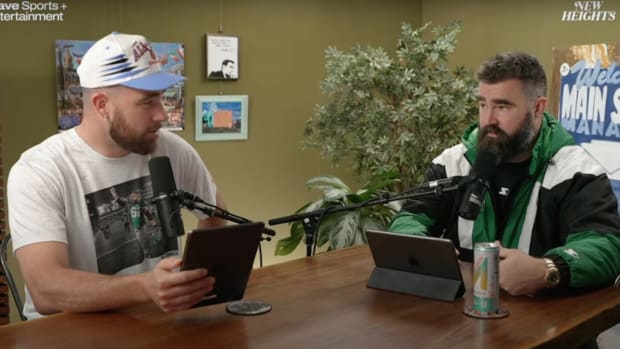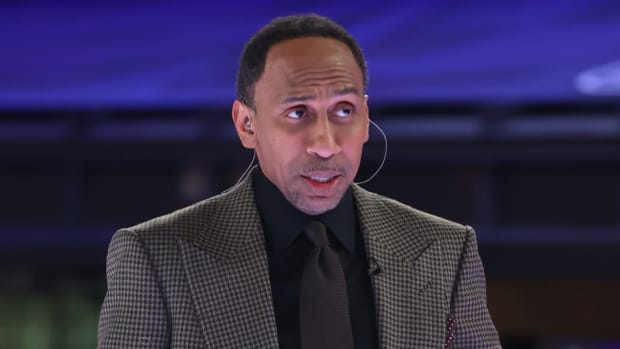Media Circus: Would you pay for 24/7 live streaming of your favorite athlete?
When asked recently whether she’d be willing to make her entire life available for public consumption—the sports version of The Truman Show—the longtime WNBA and Olympic star Sue Bird was ready to give the green light.
“I'm generally a pretty private person,” Bird said. “I don't go out of my way to be but I think it's just a part of my shyness. Ironically, though, I'd be open to this. My No. 1 reason would be that the general public has no idea what a female athlete's life is like. They think they do but it's mostly based on false generalizations. I think it would be a unique opportunity to show the truth.”
But then Bird gave the question some additional thought.
“When you think of platforms like Facebook Live, Periscope, Snapchat, etc., we are basically one step away from it already,” she wrote, via email. “Not to mention the athletes who have already done reality shows. The question that will present itself is: Who will be willing to show it all? Because obviously with social media, you have control. That's a tough ask. I mean, I saw the movie EdTV so I think I'm going to have to change my initial answer to 'No, thanks.' LOL, I don't think I could do it.”
Media Circus: Breaking down CBS and Turner's March Madness broadcast package
But would other athletes take the plunge? There is nothing to prevent Bird or any other professional athlete in 2017 from starring in a financially-successful 24/7 livestream if she or he had the right distribution platforms and content. We live in an age where endless individuals and organizations use live streaming to broadcast both the mundane and extraordinary. What is there to prevent an athlete from live streaming himself or herself 24/7 and figuring out a price point for it?
Based on my research, nothing.
“All of it is very possible and may just need that one key pioneering figure willing to Truman it up online,” said Lee Berke, president and CEO of LHB Sports, Entertainment & Media, a sports media consulting firm. “The arrival of a new name-brand sports property, a superstar that we’ll call LeBrady James, who intentionally wants to exclusively offer up a glamorous, championship- and celebrity-filled life on a 24/7 basis, would be of interest to a number of media companies, particularly those utilizing apps to drive distribution across a range of screens.
"They would have the interest and ability to distribute and profit from LeBrady’s content on flatscreens, laptops, tablets and phones. So, if LeBrady would be willing to offer up an app featuring a 24/7 livestream, short-form daily highlights, documentaries, workouts, celebrity events and so on, app-based media companies like Facebook, Twitter, Verizon, AT&T, Apple, Amazon, YouTube and Sony could all be interested, particularly if they were also involved with LeBrady’s sport. Moreover, a number of LeBrady’s key sponsors would want to be involved.”
What would be the logistics behind something like this? For that, I contacted Rick Cordella, the executive vice president and general manager of digital media for the NBC Sports Group. Cordella is responsible for all aspects of NBC Sports Group Digital, and is one of the thought leaders in the sports space.
Media Circus: A look at MLS television coverage; Alex Rodriguez joins Fox as full-time analyst
Cordella said the enterprise would have to focus on two parts to be successful—editorial logistics and technical logistics. On the editorial side, if dealing with an athlete in a team sport, all practices, pregame, postgame and the game itself would be off limits given they are team-controlled. For an athlete such as a golfer, tennis player or Olympian, Cordella said things would be a little easier but you would still have issues around competition windows and television rights.
“Then you probably get into issues around the other athletes, coaches, friends, relatives not wanting to be filmed even in social situations,” Cordella said. “You'd have to do a thorough vetting of privacy laws. I remember a story about the Manny Ramirez signing in Boston where ESPN’s Outside The Lines did some fly-on-the-wall coverage. They showed a [Yankees GM] Brian Cashman phone conversation with Ramirez's agent, Jeff Moorad, that the Yankees felt was unfair and unethical—and even illegal in some states (though N.Y. was not one of them).”
As for as the technical logistics, Cordella said you would need high-end and dependable Wi-Fi or cell coverage to be able to live stream at all times. One issue clearly would be air travel given there is not always enough bandwidth to support live streaming video on a plane. There are also geographic pockets of the U.S. where cell service isn’t strong enough. Cordella said capturing audio could be a problem if the people in the athletes’ orbit are not close enough to a microphone.
“I think you have two choices: Go the reality TV route with a full set of multiple cameras, producers, graphics, etc ... or go low-budget and have someone follow the athlete around with an iPhone,” Cordella said. “The first, as a live production, is prohibitively expensive. The second could be nauseating for the viewer as the camera shakes around. And you have the audio problems I previously mentioned. You also have to decide how you monetize this stream if that is a consideration. You could use Facebook Live, Periscope or YouTube, but you’d be stuck with their business models which in some cases are non-existent and other cases requires a significant revenue share. You could go direct to consumer and charge a fee for access, but I don't think you'd get enough subscribers. You could pay the tech costs to stream it and integrate brands (branded content), but I don't believe you’d cover your technical and production expenses.
Sam Ponder has emerged as the favorite to replace Chris Berman on Sunday NFL Countdown
“Certainly, there is a curiosity and novelty factor to it,” Cordella continued. “But I'm not sure the reality of a pro athlete’s life matches what the fan expects to see. It very well may be more routine and mundane, and the athletes carefully cultivate these public personas. I don't believe it's going to benefit the athlete to show how he/she is on his/her worst day. No human would want to be judged by one bad moment, and luckily most people don't see it. But with a 24/7 stream, that would be the clip that goes viral. An expertly edited Video On Demand show, with high production values, would do tremendously well (e.g. Cribs on MTV or Hard Knocks), but anything live is too risky to the athlete's brand and logistically/technically difficult to pull off for any sustained period of time. For sure it's an interesting idea, though.”
I wondered how many athletes would take the plunge, especially if the dollar figures were lucrative.
“It's an interesting concept for sure,” said Andy Roddick, the Hall of Fame tennis player who has worked in the sports media for the BBC and FS1, among other entities. “I personally would want no part of it. In the most honest sense, I think athletes would lose the ability to curate their images. Also, you'd have to see how it manifested itself in the self-preservation of people around them ... For example, if a publicist is giving advice in front of a live-streaming audience, they're instantly opened up to the type of criticisms that the athlete faces. If they openly talk about appealing to a certain demographic, depending on how that conversation went, a lot of Twitter warriors would come running in.”
“I'd imagine lots of NFLers would do it for the money,” said Geoff Schwartz, a nine-year NFL offensive lineman who now works in the sports media. “Lots of guys already document life 24/7 for free on Snapchat and Instagram. Money is always a motivating factor for decisions like these. I wouldn't mind live streaming my life between 7 a.m. to 7:30 p.m., when I'm busy with life and being a dad. Once my kids went down to sleep, I'd want the cameras to leave.”
Said Bird: “Define lucrative? That would be the key factor but assuming it's millions, I would guess that 25% would say they would do it. Then 15% might actually move forward, and 13% would drop out from there if the money wasn't enough. So you'd be left with the type of player that might write a tell-all book.”
Roundtable: Muslim members of the sports media on discrimination, faith, Twitter and more
Roddick said at a minimum, you would need an athlete with name value to make it interesting. “But I don't think people with the blue chip name value would want to do it,” Roddick said. “Maybe some attention 'thirsty' ones, but that would show itself quickly.”
(Roddick’s wife, the actress and model Brooklyn Decker, passed along that there would be high appeal if the livestream focused on a life that was “an absolute train wreck.”)
One of the fascinating questions would be the pricing for such an idea. Obviously, the higher the profile of the athlete, the more one would charge.
“Theoretically, an app featuring an immensely popular player with a substantial amount of exclusive content could command $4.99 per month,” Burke said. “But to build distribution and sponsorship value, it may work better to price the app at $2.99 to $3.99 per month. As for the app featuring 24/7 coverage of an 'average' professional athlete, everything would be scaled down. You’re probably looking at a regionally-popular athlete, so with a limited audience size, you scale back revenue projections and expenditures and end up with an app priced at around $.99 to $1.99 per month.”
Would there be legal ramifications for an athlete who chooses to make his or her entire life an economic enterprise?
“In general, an athlete would have extensive flexibility within his or her union to live stream their entire life,” said Michael McCann, the legal expert for Sports Illustrated and the founding director of the Sports and Entertainment Law Institute (SELI) at the University of New Hampshire School of Law, where he is also a tenured professor of law. “Players' associations, which are influenced by player agents, like to see new commercial opportunities for their members, especially opportunities that generate revenue/income that needn't be shared with owners. However, pushback from a union might occur if the athlete embarrasses himself or herself in a way that reflects poorly on other players in the union.
In the golden age of sports studio hosts, here's an attempt to draft 30 of the best
“But even then, unions can't dictate the personal lives of players. The scope of a collective bargaining agreement and accompanying employment contracts must be tied to the employment of the athlete. That contractual relationship generally doesn't extend to an athlete's private life (unless the athlete engages in legal wrongdoing, which might trigger a disciplinary response from the athlete's team or league, but not from his/her union).”
Schwartz said he believed it was a near guarantee that this would exist within the next 25 years. Roddick was a little more cautious.
“I think fans would be very interested for a moment in time,” Roddick said. “If it worked once, the market would be flooded, and I think it would actually have a short shelf life. Also, something that makes a behind-the-scenes documentary so compelling is the story for sure, but the production also plays a huge part. That element would be lost with a live stream.”
The Noise Report
(SI.com examines some of the week’s most notable sports media stories)
1. I had a number of readers contact me about what they thought was exploitative behavior by CBS Sports during its coverage of Gonzaga’s win over Northwestern. The complaints were about the broadcast production showing repeated shots of 11-year-old John Phillips, the son of Northwestern AD Jim Phillips. Young John was in near tears over Northwestern losing late in the second half.
“I think we live in a world where the producer should think of the impact on the kid rather than a few viral clicks,” said reader Patrick McIntrye, a freelance multimedia content producer from Pontiac, Mich.
“Show a couple times and be done with it,” said ESPN executive producer Lee Fitting. “Shows the passion. Don't exploit."
“Showing him once was fine,” said Seth Rothman, a researcher and writer at the YES Network. “Showing the poor kid after every basket felt cruel. It's asking the Internet to make fun of him.”
Here’s all the people who weighed in:
In my dealings with CBS Sports producers and directors, I’ve always found them to be a thoughtful lot. They are not the exploitative type. (I’d cite how they covered the Kevin Ware injury in 2013.) In this case, though, I think you have to err on the side of caution when it comes to using a kid’s image to hype the drama, even if the kid is the child of an athletic department staffer. It’s one thing to focus on a flute player in college who is part of the Villanova ecosystem; it’s another to linger on a kid whose only role is as a crowd member.
1a. CBS announcer Verne Lundquist is a gamer.
1b. Live game coverage across TBS, CBS, TNT and truTV of the NCAA Tournament through Saturday averaged 8.6 million viewers, up +2% from last year, according to CBS Sports and Turner Sports. The networks said it was the third most-watched tournament through the first three days since 1991.
1c. The NCAA First Four on truTV (last Tuesday and Wednesday) drew 5.9 million viewers, up 12% over last year.
1d. CBS drew 4.88 million viewers last Sunday for the NCAA Selection Show, down 7% from 5.25 million viewers last year, which was the previous all-time low. This is one where CBS should not sweat the lost viewers. The show was infinitely better this year than last and CBS Sports execs knows this via the overwhelmingly positive social media response to it.
1e. ESPN drew 3.6 million viewers for Duke-Notre Dame on March 11, the most-viewed ACC championship game in 20 years.
2.The Daily News reported that Rex Ryan has signed with ESPN’s NFL Countdown as a studio analyst. ESPN declined comment to SI about the report.
2a. Had plenty of people ask about the recent appearance by Zach Lowe on Bill Simmons’s podcast (as well as Simmons's appearance on Lowe’s podcast). The same questions came regarding The Ringer staffer Robert Mays appearing on the podcast of ESPN’s Bill Barnwell. As many of you know, all of these people were colleagues at Grantland before Simmons made an acrimonious exit from ESPN and ESPN killed the site. Few ESPN staffers have previously appeared on The Ringer podcasts.
Bill Simmons's first HBO documentary will focus on André the Giant
So why the rendezvous? It’s not as complicated as you might think. ESPN has always treated podcast requests on a case-by-case basis and it’ll often let high-profile staffers appear on places where there has been some corporate conflict (for example, ESPN’s Adam Schefter appears regularly on WEEI Radio in Boston, a station at the fore of the anti-ESPN sentiment in New England). Obviously, Simmons will always be a hot-button topic among some Bristol execs, but an ESPN spokesperson said, “It was a group discussion and a pretty quick one” regarding Lowe’s request. Which executives were part of this decision? ESPN did not respond to that request.
3. Episode 109 of the Sports Illustrated Media Podcast features ESPN college basketball analyst Seth Greenberg.
In this podcast, Greenberg discusses how forthcoming former-coaches-turned-broadcasters can be with their audience; how one prepares to scout the NCAA tournament; how competitive air time is at ESPN in college basketball; whether he worries about bigger-name ex-coaches coming to take his job; what producers tell him about his work; how he got into broadcasting; why certain college basketball coaches allow media access and why some don’t; his thoughts on in-game and pregame coaching interviews; his relationship with John Calipari; getting mistaken for Seth Davis on Twitter; answering questions about not giving Seth Curry a scholarship while he coached Virginia Tech; why he likes working with Jay Williams; the importance of enthusiasm on television, and much more.
You can subscribe to the podcast on iTunes, Google Play and Stitcher.
3a. Episode 110 of the Sports Illustrated Media Podcast features ESPN executive Laura Gentile, the senior vice president of espnW and Women’s Initiatives. It comes out Monday.
In this podcast, Gentile discusses the mission and business of espnW, ESPN’s first dedicated business built to serve women who love sports; why she believes espnW can last for the long haul; how ESPN has evolved for women both in front of the camera and behind the scenes over the past decade; the amount of sexism that exists among sports television and digital viewers; whether espnW is critical enough of women athletes; whether a site can succeed if it embraces optimism; what can be done regarding the online venom faced by many ESPN female staffers; the purpose of the espnW annual sports summit; the skill set one needs to be good at field hockey (Gentile was an All-America field hockey player at Duke) and much more.
4. Non sports pieces of note:
• Brilliant work from the Washington Post’s Mary Jordan and Kevin Sullivan on the immigration fight in Texas.
• An amazing piece via The Guardian’s Sam Knight: Operation London Bridge: The secret plan for the days after the Queen’s death.
• Great piece by Jessica Contrera of the Washington Post on a nurse practitioner in West Virginia and the access her patients receive to healthcare.
• Kate Starbird, an assistant professor of human centered design and engineering at the University of Washington (and, once upon a time, one of America’s best women’s basketball players), spent more than three years conducting research looking at how people spread rumors online during crisis events.
• The New Yorker’s Andrew Marantz, on trolling the White House press corps.
• An Unfinished Orson Welles Film Gets a Netflix Commitment.
• From the New York Times: In a town of 5,000, a SWAT team was outfitted for war. Here’s why.
• From The New Yorker’s Jane Mayer: The Reclusive Hedge Fund Tycoon Behind The Trump Presidency.
Sports pieces of note:
• Deadspin ran a remarkable 1981 profile written by John Schulian on Mark Aguirre, then at DePaul. Check out the access Schulian received—it would never happen today with a top college basketball player.
• Kansas City Star writer Vahe Gregorian on Gale Sayers battling dementia.
• From Maddy Myers of Complete, a look at the wild world of video game betting.
• Bill Simmons interviewed Clippers owner Steve Ballmer.
• New York Daily News writer Frank Isola on John Andariese, the longtime new York Knicks announcer who passed away at 78.
• Interesting piece by Wired on the impact of House of Highlights Instagram user, 22-year-old Omar Raja.
• From Bruce Schoenfeld of ESPN.com: Why do we know of virtually no Haitian Dominicans in the major leagues?
• Via Corey Erdman: What's It Like To Call a Boxing Match When A Riot Breaks Out.
• From Tim Keown of ESPN.com: The driving force of Russell Westbrook.
5. The legendary writer Jimmy Breslin passed away on Sunday at age 88.
Here are five Breslin pieces I’d consider must reading if interested:
• On the man who dug John F Kennedy’s grave.
• From Sports Illustrated, on the 1962 New York Mets.
• On the cops who drove a dying John Lennon to the hospital after he was shot.
• Lastly, Daily News sports columnist Mike Lupica had an elegant tribute to his former colleague.
5a. Sports writer Jeff Pearlman’s Quaz series—longform Q&As with an eclectic group of people from every walk of life—has reached subject No. 300. Check out the interviews here.
5b.New York Times writer Marc Tracy goes inside John Calipari’s social media strategy.
5c. On Tuesday (10 p.m. ET) HBO’s Real Sports has a feature on former Maryland star Juan Dixon—now the head women's basketball coach at the University of the District of Columbia—learning the identity of his biological father.
5d. An example of quality sports PR, per the company’s Kremlin blog: ESPN commentators are highlighting behind-the-scenes employees who help them do their job.
5e. FS1 airs an interesting soccer doubleheader this Friday featuring two FIFA World Cup qualifiers, including the U.S. hosting a must-win game against Honduras (10:30 p.m. ET) in San Jose, Calif., and Costa Rica traveling to EstadioAzteca in Mexico City to play Mexico (8:30 p.m. ET). John Strong, Stu Holden and Landon Donovan will call the U.S. game; Jorge Pérez-Navarro and Cobi Jones are on the call for Mexico-Costa Rica.
5f. Peter King spoke to Cris Collinsworth about replacing John Madden twice, and Washington Post reporter Rick Maese details the explosion of painkiller use in the NFL.
5g. Last month I asked Michael McCann, the legal expert for Sports Illustrated, to offer his extended thoughts on former New York Post NFL writer Bart Hubbuch’s lawsuit against the news organization. Hubbuch was fired after sending out a controversial critical tweet about Donald Trump. Last week the Post filed a motion to dismiss Hubbuch’s lawsuit. (The memorandum was passed along by a firm that represents the Post.) Once again, I’ve asked Mike to weigh in on the case. His thoughts are below:
Last month, I offered an analysis of Bart Hubbuch’s lawsuit against the New York Post over his firing on Jan. 27. This time around I discuss the Post’s memorandum of law in support of its motion to dismiss. The Post filed the memorandum last Thursday.
Some background first. Hubbuch’s 10-year employment with the Post was terminated a week after Hubbuch published a controversial tweet. About an hour before Donald Trump was sworn in as the 45th U.S. President on Jan. 20, Hubbuch tweeted “12/7/41. 9/11/01. 1/20/17.” The tweet sparked immediate criticism for implying that the day Trump became president was comparable to the day more than 2,400 Americans died at Pearl Harbor and the day nearly 3,000 people lost their lives in terrorist attacks on the World Trade Center and the Pentagon. For some, including New Yorkers who lived through 9/11, Hubbuch’s tweet was outrageous and reflected poorly on both him and his employer, the Post. Hubbuch deleted the tweet and apologized, but for some the damage was irreparable. A week later Hubbuch lost his job.
In most states, Hubbuch’s firing would not have implicated the law. He was an at-will employee—meaning he had no employment contract—and employers can fire at-will employees for any non-discriminatory reason. Hubbuch, it should be noted, makes no claim of unlawful discrimination. So if the Atlanta Journal-Constitution or the Houston Chronicle had fired Hubbuch, he’d have no case.
But it was the New York Post that fired Hubbuch and New York labor law is a bit different from labor laws found in other states. Hubbuch, through his attorney Scott Lucas, sued the Post, arguing that Rupert Murdoch’s 216-year-old newspaper violated New York Labor Law § 201-d. This law prohibits the firing of employees on account of their “legal recreational activities outside work hours, off of the employer’s premises and without use of the employer’s equipment or other property.” Hubbuch insists that his controversial tweet occurred while engaged in what he describes as a protected recreational activity: tweeting.
In a memorandum authored by attorney Steven Mintz, the Post fired back at Hubbuch. The Post offered five key arguments in hopes of convincing a state trial court to dismiss the suit.
First, the Post asserts that Hubbuch was working at the time he sent the controversial tweet. The Post highlights more than 20 emails exchanged between Hubbuch and his editor that day concerning his assignments. Hubbuch, the Post says, also submitted article drafts that day. From the Post’s vantage point, Hubbuch was ineligible to claim he was engaged in a hobby since he was working at the time of his controversial tweet.
Second, the Post highlights exceptions to the law invoked by Hubbuch. The law, as the Post stresses, does not protect employees whose recreational activities create a conflict of interest for their employer. As a result, even if Hubbuch’s tweeting constituted a hobby, rather than an extension of his employment, he seemingly created a conflict for the Post—with its predominantly New York readership and conservative-leaning perspective—by publicly comparing Trump’s inauguration to 9/11.
Third, the Post disagrees with Hubbuch’s portrayal of both the Post’s relationship to social media and how the Post regarded Hubbuch’s use of Twitter. Hubbuch argued that the Post had no particular social media policy and that his firing over an insensitive tweet came out of the blue. In sharp contrast, the Post insists that Hubbuch received and pledged to follow the Post’s detailed social media policy, which required “respectful” interactions. Further, the Post claims that Hubbuch had been repeatedly warned by his superiors to become less confrontational while on Twitter. The Post stresses that Hubbuch ignored repeated warnings and eventually had to be sternly admonished by a superior in writing.
Fourth, the Post charges that Hubbuch’s use of Twitter “was inextricably intertwined with his work as a sportswriter for the Post.” The Post highlights how Hubbuch communicated with Post readers in his capacity as a Post writer. That said, the paper concedes—albeit in a backhanded way—that Hubbuch used Twitter for other purposes as well: “He communicated sports commentary [on Twitter] as well as a variety of random personal insults and political thoughts.”
But the Post insists that New York law’s depiction of so-called “leisure-time activities” comprise activities that are distinctly outside the scope of work and that a journalist’s use of Twitter does not fall within such a limitation. For example, playing sports, exercising, watching TV and playing videogames are all activities that, for most employees, are unrelated to their work. Also, in many instances, these activities occur in closed communities, such as in a gym or one’s living room.
Twitter is very different. For starters, unless one has set his or her Twitter account to private, Twitter is—by design—public. Plus, for journalists, Twitter is generally either an extension of work life or a mixed vehicle for publicly promoting writings, elevating reputation and expressing views about different aspects of culture. Indeed, in the media industry in which journalists now operate, journalists are to some degree judged by their social media presence. A wider presence usually means more clicks for articles written by those journalists. This dynamic works against Hubbuch’s portrayal of Twitter as a mere hobby.
As a fifth rationale, the Post argues it would be a violation of its First Amendment right to control the content of its editorial message if it could not fire an employee who tweeted offensive content. The Post stresses that Hubbuch occupied a “high-profile” job as a writer for the Post, the seventh largest newspaper in the U.S. by circulation, and his public remarks were indivisibly linked to that job.
The Post also asks for Hubbuch and Lucas (his attorney) to be sanctioned for filing what the Post argues are knowingly false allegations. Sanctions are within the discretion of the court. Judges, however, are often reluctant to impose them absent very compelling evidence.
Hubbuch and Lucas will have an opportunity to respond to the Post’s motion in writing. We’ll keep you updated on key developments.

